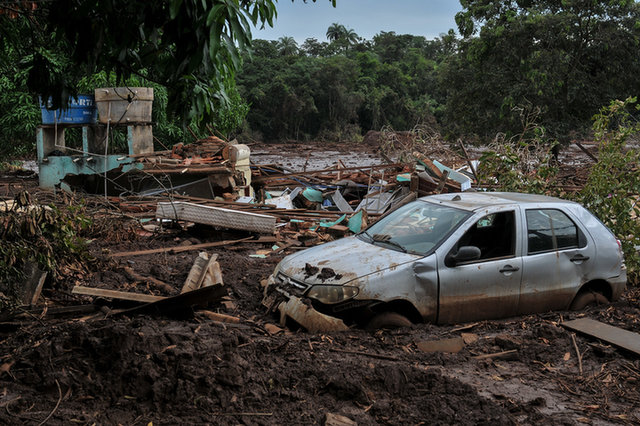SAFETY
Above and beyond the tailings standards for all mines
In August, a mining industry panel published the Global Industry Standard on Tailings Management. The projects with the potential to cause the most damage now have three years to shape up. Matt Farmer finds out how the new rules will change mining and prevent dam disasters.


T
he board of the Global Tailings Review created the Global Industry Standard on Tailings Management after the Brumadinho dam disaster, a tailings dam collapse in Brazil that killed at least 270 people on 25 January 2019. A sudden mudslide hit the local town, destroying the community and changing the local landscape. Mine owner Vale has faced fines of $1.47bn, executive arrests, and a regulatory crackdown as a direct result of the collapse.
It later emerged that Vale had reason to doubt the integrity of the dam but the company did not take action on the information. While an industry body had already published a tailings framework, the tailingsdisasters continued. Now, the new standards aim to stop catastrophes like this from happening again.
To create the regulations, the UN Environment Programme collaborated with UN-backed investors network Principles for Responsible Investment and the International Council for Mining and Minerals (ICMM).
In an ICMM statement from the time, CEO Tom Butler said that the new standards marked a "significant step" toward greater tailings safety. He continued: “The standard will be integrated into ICMM’s existing member commitments, which includes third party assurance and validation, and we are in the process of developing supporting guidance.
“Members have committed that all facilities with ‘extreme’ or ‘very high’ potential consequences will be in conformance with the standard within three years of today, and all other facilities within five years."
More than half of the country’s coal mines are managed by pro-Russian separatist militia.Credit: DmyTo/Shutterstock.
More than half of the country’s coal mines are managed by pro-Russian separatist militia.
Credit: DmyTo/Shutterstock.
"Ambitious" reform timeline allows companies to prioritise
ICMM represents 27 of the largest mining companies, including several involved in previous tailings disasters. COO Aidan Davy tells us that the timeline for enforcement was "ambitious", explaining further that “this reflects the importance of this issue to our members, and was set so that companies could prioritise the conformance of facilities with higher potential consequences.
“The amount of difficulty in implementing these standards partly comes from the maturity and robustness of companies’ existing practices for tailings management. Demonstrating conformance will involve a significant effort for most companies.
“The transparency associated with our disclosure requirements will make it clear if companies are not in conformance, and what they intend to do to address this.”
“The amount of difficulty in implementing these standards partly comes from the maturity and robustness of companies’ existing practices.”
The standards’ disclosure requirements mandate public disclosure of tailings safety information. This would include easy-to-understand explanations of a dam’s design and placement, as well as an outline of the consequences of a collapse.
Davy says that these policies would make it clear when companies do not conform, and ensure they show how they intend to fix issues.

The Brazilian region of Minas Gerais has faced two tailings failures in the last five years. Image: Ibama/Flickr
Who will enforce global tailings standards?
ICMM has said that it will incorporate the standards into its member commitments. This alone will cover most of the largest mining companies, with assurance from third-party auditors.
Davy says: “We are developing a conformance protocol that integrates the standard into our existing member commitments. This will be a working document, to be used by companies or suitably-qualified independent third parties to evaluate tailings facility conditions against the standard’s requirements. Once the material is ready, it will be publicly available on our website for the benefit of the wider industry.
“We are developing a conformance protocol that integrates the standard into our existing member commitments.”
“The standard itself includes numerous requirements for independent oversight as an integral part of how companies manage their tailings facilities. For example, external and independent third parties will oversee the analysis of sites for new tailings facilities, how tailings storage is classified based on the consequences of failure, and the conduct of risk assessments. The standard allows for flexibility in how its goals are achieved, which is particularly important given the varied geographical contexts.”
The string of disasters has also brought greater attention to tailings monitoring technology. For instance, companies have investigated big-data methods of monitoring dam safety and looked to link datasets from multiple risk management tools. These would operate above the Global Standard’s outline, for operators looking for better mining practices.

The Mount Polley tailings disaster caused significant backlash in British Columbia. Image: Jeremy Board/Flickr
Best practice and settling issues at a national level
The standards’ preamble clarifies that it does not cover all considerations. It reads: “Issues have arisen in the development of the standard that are difficult to translate into an auditable industry standard for operators.
“These issues are more appropriately addressed through national and/or state level regulatory authorities, or through multilateral agencies working with the industry.”
The preamble gives the example of finding the owners of ‘orphaned’ mines and dams. In these cases, the accountable party is unclear, or the mine owner lacks the ability to carry out a clean up. Global governments have issued different guidance documents on how to treat such scenarios, which, combined with differing property laws, made a global standard unfeasible.
“We agreed that the review would not look to exclude certain technologies such as upstream tailings facilities from future use.”
Davy continues: “We all agreed that two other aspects were beyond the scope of the review: detailed design criteria for tailings facilities and the exclusion of certain technologies.
“Our sense was that detailed technical design criteria for tailings dams are already covered by organisations such as the International Commission on Large Dams.
“From the outset, we agreed that the review would not look to exclude certain technologies such as upstream tailings facilities from future use. While individual governments may decide to make that choice, it would be inappropriate for the Review panel to do so.”
While it does not address all issues, Davy says he believes that the standards improve the global benchmark for good tailings practice. This still leaves operators to design their own procedures in order to achieve best practice but soon, this too will have worldwide guidance.
Davy continues: “ICMM is in the process of developing a Good Practice Guide for Tailings Management for members and the wider mining and metals industry, intended to support the implementation of good governance and engineering practices for tailings management across the lifecycle, including a performance-based, risk-informed approach where appropriate.”

AusProof is celebrating 25 years of business in Australia in 2019.
